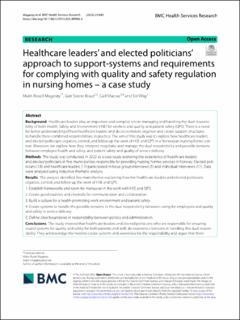| dc.contributor.author | Magerøy, Malin Emilia Rosell | |
| dc.contributor.author | Braut, Geir Sverre | |
| dc.contributor.author | Macrae, Carl James | |
| dc.contributor.author | Wiig, Siri | |
| dc.date.accessioned | 2023-09-18T11:25:16Z | |
| dc.date.available | 2023-09-18T11:25:16Z | |
| dc.date.created | 2023-09-07T10:20:22Z | |
| dc.date.issued | 2023 | |
| dc.identifier.citation | BMC Health Services Research. 2023, 23 (1), . | en_US |
| dc.identifier.issn | 1472-6963 | |
| dc.identifier.uri | https://hdl.handle.net/11250/3090057 | |
| dc.description.abstract | Background
Healthcare leaders play an important and complex role in managing and handling the dual responsibility of both Health, Safety and Environment (HSE) for workers and quality and patient safety (QPS). There is a need for better understanding of how healthcare leaders and decision makers organize and create support structures to handle these combined responsibilities in practice. The aim of this study was to explore how healthcare leaders and elected politicians organize, control, and follow up the work of HSE and QPS in a Norwegian nursing home context. Moreover, we explore how they interpret, negotiate, and manage the dual responsibility and possible tensions between employee health and safety, and patient safety and quality of service delivery.
Methods
The study was conducted in 2022 as a case study exploring the experience of healthcare leaders and elected politicians in five municipalities responsible for providing nursing homes services in Norway. Elected politicians (18) and healthcare leaders (11) participated in focus group interviews (5) and individual interviews (11). Data were analyzed using inductive thematic analysis.
Results
The analysis identified five main themes explaining how the healthcare leaders and elected politicians organize, control, and follow up the work of HSE and QPS:
1. Establish frameworks and room for maneuver in the work with HSE and QPS.
2. Create good routines and channels for communication and collaboration.
3. Build a culture for a health-promoting work environment and patient safety.
4. Create systems to handle the possible tensions in the dual responsibility between caring for employees and quality and safety in service delivery.
5. Define clear boundaries in responsibility between politics and administration.
Conclusions
The study showed that healthcare leaders and elected politicians who are responsible for ensuring sound systems for quality and safety for both patients and staff, do experience tensions in handling this dual responsibility. They acknowledge the need to create systems and awareness for the responsibility and argue that there is a need to better separate the roles and boundaries between elected politicians and the healthcare administration in the execution of HSE and QPS. | en_US |
| dc.language.iso | eng | en_US |
| dc.publisher | BioMed Central | en_US |
| dc.rights | Navngivelse 4.0 Internasjonal | * |
| dc.rights.uri | http://creativecommons.org/licenses/by/4.0/deed.no | * |
| dc.title | Healthcare leaders’ and elected politicians’ approach to support-systems and requirements for complying with quality and safety regulation in nursing homes – a case study | en_US |
| dc.type | Peer reviewed | en_US |
| dc.type | Journal article | en_US |
| dc.description.version | publishedVersion | en_US |
| dc.rights.holder | © The Author(s) 2023 | en_US |
| dc.source.pagenumber | 0 | en_US |
| dc.source.volume | 23 | en_US |
| dc.source.journal | BMC Health Services Research | en_US |
| dc.source.issue | 1 | en_US |
| dc.identifier.doi | 10.1186/s12913-023-09906-6 | |
| dc.identifier.cristin | 2173118 | |
| dc.source.articlenumber | 880 | en_US |
| cristin.ispublished | true | |
| cristin.fulltext | original | |
| cristin.qualitycode | 2 | |

